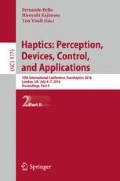Abstract
Considerable advancements in vibratory and auditory feedback have transformed the touchscreen from a simple visual input/output device to one that is highly interactive and multimodal. While auditory feedback is useful in tasks where dictation is sufficient, it can be tedious and limited in tasks that require interpretation of graphics. In this work, we focus on exploration procedures, identification accuracy of graphics, and how repetition at smaller scales may help users identify similar graphics when only vibratory feedback is used on touchscreens. We conducted shape identification tasks with 56 blindfolded participants. Results suggest users are able to reliably identify basic 2D shapes within 90 s using only haptic feedback. Users were also able to identify smaller shapes with thin vibrating borders at rates comparable to their larger counterparts after being exposed to the larger shapes first. We also make observations on successful exploratory procedures employed and compare approaches among users. These findings serve to inform non-visual interface design using haptic feedback capabilities on touchscreens.
Access this chapter
Tax calculation will be finalised at checkout
Purchases are for personal use only
References
Minogue, J., Jones, M.G.: Haptics in education: exploring an untapped sensory modality. Rev. Educ. Res. 76(3), 317–348 (2006)
Levesque, V., Oram, L., MacLean, K., Cockburn, A., Marchuk, N., Johnson, D., Colgate, J., Peshkin, M.: Enhancing physicality in touch interaction with programmable friction. In: Computer and Human Interaction, pp. 2481–2490 (2011)
Akamatsu, M., MacKenzie, I.: Movement characteristics using a mouse with tactile and force feedback. Int. J. Hum. Comput. Stud. 45, 483–493 (1996)
Pitts, M., Burnett, G., Skrypchuk, L., Wellings, T., Attrige, M., Williams, A.: Visual-haptic feedback interaction in automotive touchscreens. Displays 33, 7–16 (2012)
Leung, R., MacLean, K., Bertelsen, M., Saubhasik, M.: Evaluation of a haptically augmented touchscreen gui elements under congitive load. In: International Conference on Multimodal Interfaces, pp. 374–381 (2007)
Goncu, C., Marriott, K.: GraVVITAS: generic multi-touch presentation of accessible graphics. In: Campos, P., Graham, N., Jorge, J., Nunes, N., Palanque, P., Winckler, M. (eds.) INTERACT 2011, Part I. LNCS, vol. 6946, pp. 30–48. Springer, Heidelberg (2011)
Mullenbach, J., Shultz, C., Colgate, J.E., Piper, A.M.: Exploring affective communication through variable-friction surface haptics. In: Proceedings of the SIGCHI Conference on Human Factors in Computing Systems, pp. 3963–3972. ACM (2014)
Bau, O., Poupyrev, I., Israr, A., Harrison, C.: Teslatouch: Electrovibration for touch surfaces. In: Proceedings of the 23nd Annual ACM Symposium on User Interface Software and Technology, pp. 283–292. ACM (2010)
O’Modhrain, S., Giudice, N.A., Gardner, J.A., Legge, G.E.: Designing media for visually-impaired users of refreshable touch display: possibilities and pitfalls. Trans. Haptics 8(3), 248–257 (2015)
Klatzky, R.L., Giudice, N.A., Bennett, C.R., Loomis, J.M.: Touch-screen technology for the dynamic display of 2d spatial information without vision: promise and progress. Multisensory Res. 27, 359–378 (2014)
Palani, H.P., Giudice, N.A.: Evaluation of non-visual panning operatoins using touch-screen devices. In: Proceedings of the 16th International ACM SIGACCESS Conference on Computers & Accessibility, pp. 293–294. ACM (2014)
Giudice, N.A., Palani, H.P., Brenner, E., Kramer, K.M.: Learning non-visual graphical information using a touch-based vibro-audio interface. In: Proceedings of the 14th International ACM SIGACCESS Conference on Computers & Accessibility, pp. 103–110. ACM (2012)
Craig, J.C.: Anomalous sensations following prolonged tactile stimulation. Neuropsycholog 31(3), 277–291 (1993)
Gentaz, E., Hatwell, Y.: Geometrical haptic illusions: the role of explorationin the mller-lyer, verticalhorizontal, and delboeuf illusions. Psychon. Bull. Rev. 11(1), 31–40 (2004)
Klatzky, R.L., Lederman, S.J., Metzger, V.A.: Identifying objects by touch: an “expert system”. Percept. Psychophysics 37(4), 299–302 (1985)
Klatzky, R.L., Lederman, S.J., Reed, C.: There’s more to touch than meets the eye: the salience of object attributes for haptics with and without vision. J. Exp. Psychol. Gen. 116(4), 356–369 (1987)
Davidson, P.W.: Haptic judgments of curvature by blind and sighted humans. J. Exp. Psychol. 93(1), 43–55 (1972)
Vinter, A., Fernandes, V., Orlandi, O., Morgan, P.: Exploratory procedures of tactile images in visually impaired and blindfolded sighted children: how they relate to their consequent performance in drawing. Res. Dev. Disabil. 33, 1819–1831 (2012)
Withagen, A., Kappers, A.M., Vervloed, M.P., Knoors, H., Verhoeven, L.: Haptic object matching by blind and sighted adults and children. Acta Psychologi. 139, 261–271 (2012)
Lederman, S.J., Klatzky, R.L.: Hand movements: a window into haptic object recognition. Cognitive Psychol. 19, 342–368 (1987)
Magee, L.E., Kennedy, J.M.: Exploring pictures tactually. Nature 283, 287–288 (1980)
Raja, M.K.: The development and validation of a new smartphone based non-visual spatial interface for learning indoor layouts, Master’s thesis, The University of Maine (2011)
Gorlewicz, J.L., Burgner, J., Withrow, T.J., Webster III, R.J.: Initial experiences using vibratory touchscreens to display graphical math concepts to students with visual impairments. J. Spec. Educ. Technol. 29(2), 17–25 (2014)
Millar, S.: Space and Sense. Psychology Press, New York (2008)
Immersion. Immersion developer zone (2015). http://www2.immersion.com/developers/
Author information
Authors and Affiliations
Corresponding author
Editor information
Editors and Affiliations
Rights and permissions
Copyright information
© 2016 Springer International Publishing Switzerland
About this paper
Cite this paper
Tennison, J.L., Gorlewicz, J.L. (2016). Toward Non-visual Graphics Representations on Vibratory Touchscreens: Shape Exploration and Identification. In: Bello, F., Kajimoto, H., Visell, Y. (eds) Haptics: Perception, Devices, Control, and Applications. EuroHaptics 2016. Lecture Notes in Computer Science(), vol 9775. Springer, Cham. https://doi.org/10.1007/978-3-319-42324-1_38
Download citation
DOI: https://doi.org/10.1007/978-3-319-42324-1_38
Published:
Publisher Name: Springer, Cham
Print ISBN: 978-3-319-42323-4
Online ISBN: 978-3-319-42324-1
eBook Packages: Computer ScienceComputer Science (R0)

